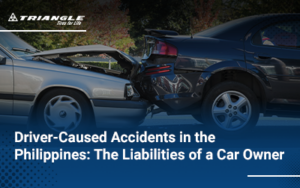With the rainy season returning, the roads are becoming challenging terrain for drivers, especially those who don’t have as much experience. According to the Metropolitan Manila Development Authority (MMDA), the region experiences the most road accidents during the rainy months, from July to October.
Even a drizzle can drastically change road conditions, so you can expect heavy rains to have significant effects. Navigating through a downpour requires unique skills to ensure safety and avoid potential accidents.
This article provides essential tips to help you master driving in slippery conditions. Understanding these nuances can help you handle the challenges of rain-soaked roads and travel safely daily.
How to Drive in Heavy Rain
Navigating through heavy rain requires more than just turning on your windshield wipers—though that’s an excellent first step! Here are essential tips to keep in mind for a safe and controlled drive.
1. Avoid it, if possible
Sometimes, the safest option is to avoid driving during intense rainstorms. If you can’t delay your trip until the rain lets up, find an alternative mode of transportation. Likewise, asking a more experienced driver to take over is prudent.
When you drive in heavy rain, you expose yourself to potential hazards on rain-soaked roads. You also contribute to the risk of accidents by increasing the number of vehicles on the streets.
2. Stay alert at all times
Road visibility is much lower for cars during heavy rain, demanding heightened awareness. Keep both hands on the steering wheel, minimize distractions, and stay focused on the road. Stay vigilant so you can react to sudden changes in traffic or road conditions.
3. Maintain a slower speed
Road authorities design speed limits for optimal conditions, so reduce your speed significantly to account for the downpour. This precaution provides you with more time to react to any unexpected situations.
Plus, maintaining a slower speed can reduce the chances of your tires from hydroplaning—preventing the loss of vehicular control on slippery roads.
4. Turn on your headlights
Visibility is crucial during rain, so turn on your headlights to see better and make your vehicle more visible to others. This step is not only helpful for your safety but also for drivers who might find it hard to spot your car in the rain.
However, avoid using high beams, as the powerful light can create glare by reflecting off wet surfaces and raindrops. The light can further reduce your visibility and momentarily blind oncoming drivers, making the situation even more dangerous.
5. Follow the next car from a safe distance
Maintain a decent following distance from the vehicle in front of you, and take note if the car behind you is doing the same. Wet roads decrease traction, meaning your stopping distances will be significantly longer. Ample break space will help you and other drivers brake gradually and avoid abrupt, dangerous stops.
6. Know how to avoid fogging up your windshield
Rain reduces the ambient temperature outside your vehicle, meaning any moisture in the air inside your car is more likely to turn into condensation once it hits your colder windows. The condensed water is what causes your windshield to fog up.
You can use an anti-fog solution if you know you’ll drive in the rain. However, if the rain catches you mid-drive, your car’s air conditioner might have a defrost option that can help with fogging.
7. Don’t drive through flooded areas
Heavy rain inevitably brings floods to many streets in the Philippines. Driving through floods can cause potential damage to your car’s engine and electrical systems. The standing water on the road can also lead to hydroplaning, a dangerous situation where the water causes your tires to lose contact with the road.
8. Ensure your car is well-maintained
Proper car maintenance is paramount for safe driving in any weather. Regularly check your brakes, windshield wipers, lights, and tires to ensure they function correctly. Adequate care improves your car’s responsiveness and ability to navigate challenging conditions.
9. Equip your car with high-traction tires
When driving in heavy rain, the condition of your tires is critical in maintaining control and stability. Worn-out tire treads have less grip, making them more prone to hydroplaning. Ideally, you inspect tires regularly and replace those that show wear and tear.
High-traction tires are wheels that excel in wet conditions by offering a superior grip on slippery surfaces. Unlike standard tires, these specialized wheels feature unique tread patterns and rubber compounds that disperse water effectively and maintain contact with the road.
Consider upgrading to tires like the TR-256 Sportex, a superior wet-weather option. Investing in these tires can significantly improve your driving experience during heavy rain, minimizing the risks of reduced traction.
Steering Through Storms
Heavy rains are an unfortunate reality in the Philippines. As such, mastering the techniques to navigate them is not just a skill but a necessity. These tips safeguard your journey and the safety of those around you.
If downpours are a constant companion in your location, equipping your vehicle with high-traction tires is a must. Triangle Tires offers a comprehensive selection of quality tires that cater to diverse vehicle types. Explore our tire catalog, or get in touch to discover how we can help you travel safely, rain or shine.


